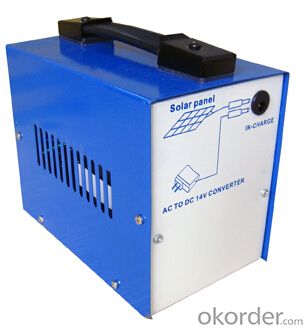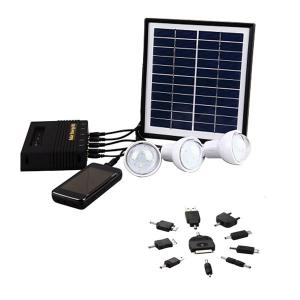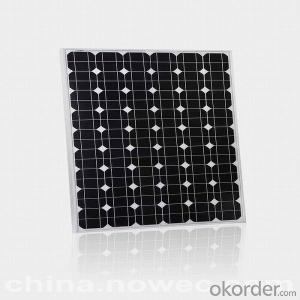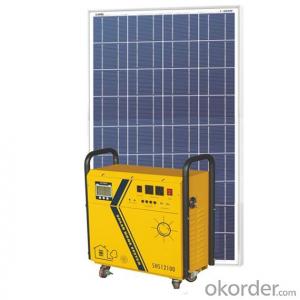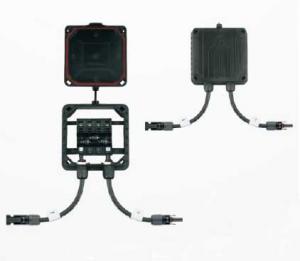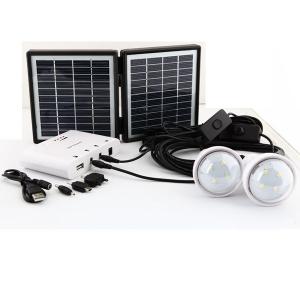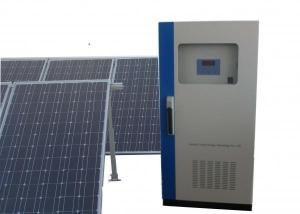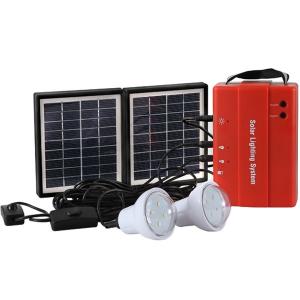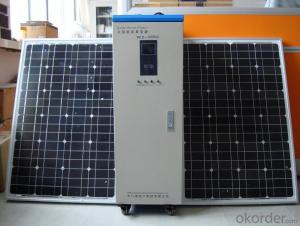4Ah/ 6W Solar Home System for Lighting Model SHS1206
- Loading Port:
- Shanghai
- Payment Terms:
- TT OR LC
- Min Order Qty:
- 5 set
- Supply Capability:
- 150 set/month
OKorder Service Pledge
OKorder Financial Service
You Might Also Like
1. Structure of 4Ah Solar Home System for lighting Model SHS1206
4Ah DC/6W Solar Home System is designed for the small family. All the power comes from solar energy, clean and friendly to environment.
This system is usually used for home lighting/house lighting: such as remote area, mountainous area, desert area, grassland area, village, country area, camping, outdoor activities, travelling for light at night. It will play an important role in daily life.4AH DC solar power system has following components:
1.Solar module: 12V/6W. With 8m cable and 2.1mm DC port,poly crystalline. (one set)
2.LED lights, 12V/3W, white color. With 4m cable and 2.1mm DC port. (two sets)
3.Battery box with controller built-in. (one set)
2. Main Features of Solar Home System for lighting Model SHS1206
· Smart shape
· Convenient to carry about
· Better integrality: all components are in the packaging, put into use immediately after open the packaging
· Easy to make the assembly
3. Solar Home System for lighting Model SHS1206 Specification
product name | rated charging current | rated working voltage | float charging voltage | low voltage disconnecting point | USB port current | working temperature | dimension |
4Ah DC solar home system | 1A | 12V | 14V | 10.5V | ≤500mA | -10℃~50℃ | 160mm×96mm×135mm |
model | rated discharge current | solar panel voltage | no load loss | low voltage reconnecting point | humidity requirement | storage temperature | |
SHS1206 | 2A | ≤25 | ≤8mA | 11.5V | ≤90%,no condensation | -15℃~40℃ |
4. Solar Home System for lighting Model SHS1206 Images

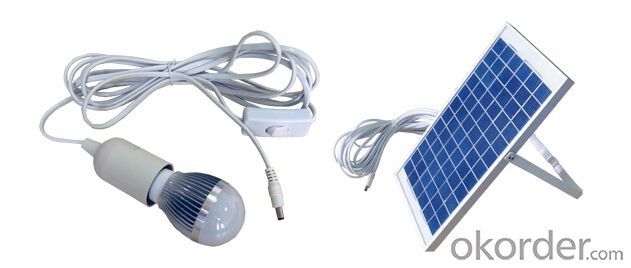
5. FAQ
We have organized several common questions for our clients, which may help you sincerely:
1) How to guarantee the quality of the products?
The company is approved by the ISO9000 quality management system with its strict product quality control. The products for exportation pass the inspection of relevant foreign nations (CE, ROHS), and get high evaluation of the customers.
2) How long can we receive the product after signing Sales Confirmation?
Generally speaking, if there is enough quantity of finished products which can meet the clients’ requirement, we can manage the delivery within three to five working days according to the instruction of the payment terms in the Sales Confirmation; if the products need some time to get ready, we will arrange thedelivery as soon as possible after the manufacture.
- Q: How do solar energy systems impact the reduction of energy transmission losses?
- Solar energy systems help reduce energy transmission losses in multiple ways. First, solar energy systems generate electricity at or near the point of consumption, eliminating the need for long-distance transmission lines. This reduces transmission losses that occur when electricity is transported over extensive distances. Additionally, solar energy systems operate on a decentralized model, meaning they are often installed on rooftops or in close proximity to the consumers. This proximity further reduces transmission losses as the generated electricity does not have to travel far to reach the end-users. Furthermore, solar energy systems convert sunlight directly into electricity without the need for intermediate steps like combustion or steam generation. This direct conversion eliminates the energy losses that occur during these intermediate processes, making solar energy systems more efficient in converting sunlight into usable electricity. Overall, solar energy systems contribute significantly to the reduction of energy transmission losses by generating electricity locally, minimizing the need for long-distance transmission lines, and operating on a direct and efficient conversion process.
- Q: Can solar energy systems be used in powering religious institutions like churches or temples?
- Certainly, churches or temples can utilize solar energy systems to power their operations. These buildings are particularly suitable for solar power due to their spacious roofs that can accommodate solar panels. By installing these systems, religious institutions can significantly decrease their electricity expenses, save money, and become more sustainable. Sunlight is converted into usable energy by solar panels, which can then be employed to fulfill the religious institution's lighting, heating, cooling, and other electrical requirements. Recent advancements in solar technology have made it possible to store surplus energy in batteries, ensuring uninterrupted power even on cloudy days or during the night. The usage of solar energy not only reduces the operational costs of religious institutions but also aids in reducing their carbon footprint. By minimizing reliance on fossil fuels, solar power systems contribute to mitigating climate change and advocating for environmental stewardship. This resonates with the core principles of numerous religious organizations that emphasize the significance of environmental sustainability and responsible Earth stewardship. Moreover, solar energy systems can serve as visible demonstrations of the religious institution's dedication to sustainable practices, inspiring both members and the wider community to adopt renewable energy solutions. By embracing solar power, religious institutions can showcase their commitment to caring for the planet and encourage others to do the same. To summarize, solar energy systems can effectively power religious institutions such as churches or temples. They present an eco-friendly and economical solution that aligns with the values of many religious organizations. By embracing solar power, these institutions can reduce their energy costs, promote sustainability, and inspire their members and the community to embrace clean energy solutions.
- Q: How do solar energy systems impact energy resilience during natural disasters?
- Solar energy systems can significantly enhance energy resilience during natural disasters. These systems provide a reliable and sustainable source of electricity, allowing essential services such as hospitals, emergency response centers, and water treatment plants to continue functioning even when the traditional power grid is disrupted. Solar panels can generate power independently, reducing the reliance on vulnerable fuel supply chains and reducing the risk of power outages. Moreover, solar energy systems can also contribute to the overall community resilience by providing power for charging essential devices, refrigeration of medicines, and lighting in homes, thus improving the well-being and safety of affected individuals during challenging times.
- Q: How do solar energy systems impact energy security?
- Solar energy systems can greatly enhance energy security by diversifying the energy mix and reducing dependence on traditional fossil fuels. They provide a decentralized and sustainable source of energy, reducing the vulnerability to disruptions in the supply chain and geopolitical tensions. Furthermore, solar energy systems contribute to grid stability and resilience, as they often include energy storage capabilities.
- Q: Can solar energy systems be financed?
- Yes, solar energy systems can be financed through various options such as loans, leases, power purchase agreements (PPAs), and government incentives. These financial options make it easier for homeowners, businesses, and organizations to invest in solar energy and benefit from long-term energy savings.
- Q: What is the impact of bird droppings on solar panel efficiency?
- Bird droppings have a negative impact on solar panel efficiency as they can block sunlight from reaching the surface of the panels, reducing their ability to generate electricity. Regular cleaning and maintenance are necessary to ensure optimal performance and prevent any long-term damage.
- Q: Can solar energy systems be used for recreational vehicles or boats?
- Yes, solar energy systems can be used for recreational vehicles or boats. These systems can provide power for various appliances and electronics, making them suitable for off-grid camping or sailing. Solar panels can be installed on the roof or deck of the vehicle or boat, and the energy generated can be stored in batteries for later use. This allows for a sustainable and convenient power source while enjoying outdoor activities.
- Q: What is the lifespan of a solar battery?
- The lifespan of a solar battery can vary depending on various factors such as the quality of the battery, usage patterns, and maintenance. On average, a well-maintained solar battery can last anywhere from 5 to 15 years. However, with advancements in technology and improvements in battery manufacturing, some high-quality solar batteries have been known to last up to 20 years or more.
- Q: Do solar panels work on cloudy days?
- Yes, solar panels can still generate electricity on cloudy days, although their efficiency may be reduced. Cloud cover decreases the amount of sunlight reaching the panels, resulting in a lower energy output compared to sunny days. However, solar panels are still able to convert diffuse sunlight into electricity, making them functional even in less than ideal weather conditions.
- Q: Can solar energy systems be used in historical or protected buildings?
- Yes, solar energy systems can be used in historical or protected buildings. In fact, incorporating solar energy systems into such buildings can be a smart and sustainable solution. While the installation of solar panels on historical or protected buildings might require careful planning and consideration, it is certainly possible to preserve the integrity and aesthetics of the architecture while benefiting from renewable energy sources. One approach to installing solar energy systems on historical or protected buildings is by using integrated solar panels. These panels are designed to blend seamlessly with the building's design and are installed in a way that does not alter the historical features. This can be achieved by placing the solar panels on flat roofs, using solar tiles, or installing solar panels on less visible parts of the building, such as the rear or sides. Another consideration when installing solar energy systems on historical or protected buildings is the preservation of the building's structural integrity. This can be done by employing non-penetrating mounting systems that do not require drilling or damaging the building's structure. Additionally, consultation with architects, engineers, and preservation experts is crucial to ensure the installation process adheres to any preservation guidelines or regulations. By embracing solar energy systems, historical or protected buildings can become more sustainable and reduce their carbon footprint. Solar panels can provide a clean and renewable source of electricity, reducing dependence on fossil fuels and decreasing greenhouse gas emissions. Moreover, solar energy systems can often generate enough power to meet the energy needs of these buildings, making them self-sufficient and potentially even providing surplus energy that can be fed back into the grid. In conclusion, solar energy systems can indeed be used in historical or protected buildings with careful planning and consideration. By utilizing integrated solar panels and consulting with preservation experts, it is possible to harness the benefits of renewable energy while preserving the architectural and historical value of these buildings. This approach not only ensures a sustainable future but also showcases the harmonious coexistence of modern technology and historical preservation.
Send your message to us
4Ah/ 6W Solar Home System for Lighting Model SHS1206
- Loading Port:
- Shanghai
- Payment Terms:
- TT OR LC
- Min Order Qty:
- 5 set
- Supply Capability:
- 150 set/month
OKorder Service Pledge
OKorder Financial Service
Similar products
Hot products
Hot Searches
Related keywords



